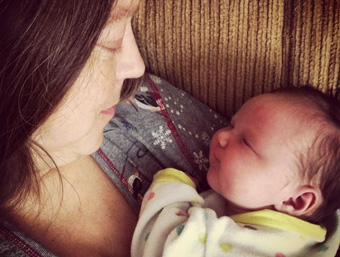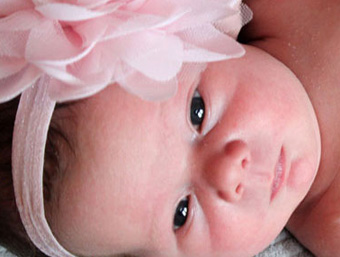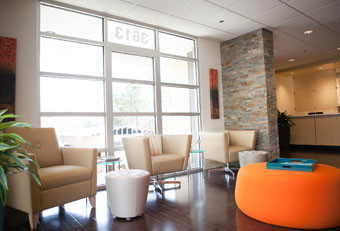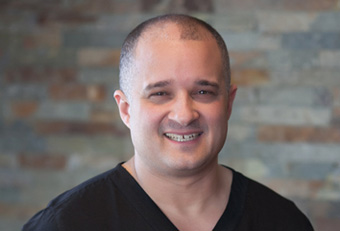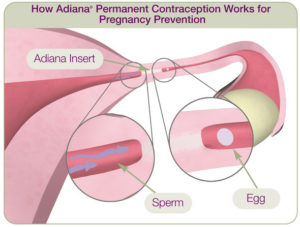 Adiana sterilization is considered permanent but Adiana can be reversed.
Adiana sterilization is considered permanent but Adiana can be reversed.
Successful pregnancy is possible after surgical reversal of Adiana tubal blockage.
Adiana sterilization is similar to Essure sterilization. Both methods use devices to cause permanent blockage inside the very beginning of the fallopian tube.
Both methods can be reversed by Dr. Monteith of A Personal Choice with a tubouterine implantation procedure and the chance of pregnancy is approximately 40%.
Adiana And Essure: They Both Do The Same Thing
Essure was approved by the FDA in 2002. The Essure fallopian tube device is a 2 inch nickel/stainless steel coil. Each device is inserted into the opening of each fallopian tube. The Essure device causes scar tissue formation inside the beginning of the tube. This causes permanent blockage.
Adiana was approved for use in the United States in 2009. The Adiana device is a small silicone insert. It is the same size as a grain of rice.
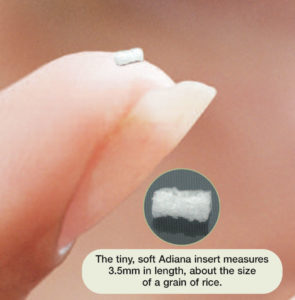 The Adiana device is inserted into the opening of fallopian tube. The Adiana causes tubal blockage just like Essure and is intended to be permanent.
The Adiana device is inserted into the opening of fallopian tube. The Adiana causes tubal blockage just like Essure and is intended to be permanent.
The Adiana device was removed from the health care market in 2012 after the makers of Essure complained the Adiana device violated the preexisting patents on Essure.
Adiana was only in use for 3 years. Adiana has not been used on as many women.
Adiana can be reversed surgically. Natural pregnancy after reversal is possible.
Can Adiana Be Reversed?
Dr. Monteith is a world renowned tubal reversal surgeon. He was the first surgeon to report successful surgical reversal of Adiana sterilization.
 Dr. Monteith’s first Adiana reversal patient lost her teenage son to a drowning accident. Unfortunately she was one of the first Adiana trial patients. Her tubes were blocked from the Adiana devices. She wanted to become pregnant again.
Dr. Monteith’s first Adiana reversal patient lost her teenage son to a drowning accident. Unfortunately she was one of the first Adiana trial patients. Her tubes were blocked from the Adiana devices. She wanted to become pregnant again.
She declined in-vitro fertilization (IVF). She consulted with Drs. Monteith and Berger (retired) because of their extensive tubal reversal surgery experience.
She chose to have outpatient Adiana reversal. The procedure was successful and she soon had a healthy baby girl.
Tina’s first testimonial: Adiana reversal Complete Success
Tina’s first pregnancy update: Adiana Sterilization Reversal: Our Baby Girl Turns 4
Tina was the first patient in the world to have successful Adiana reversal.
This first case of successful Adiana sterilization reversal was written by Dr. Monteith and published in the Journal of Fertility and Sterility: Normal pregnancy after outpatient tubouterine implantation in patient with Adiana sterilization
Is Pregnancy Possible After Adiana Reversal?
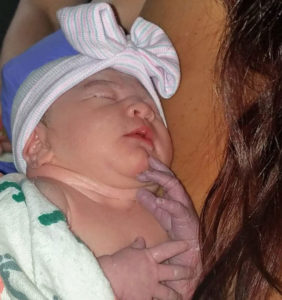 Pregnancy is possible after Adiana reversal. Dr. Monteith uses the same procedure to reverse Adiana as he does to reverse Essure.
Pregnancy is possible after Adiana reversal. Dr. Monteith uses the same procedure to reverse Adiana as he does to reverse Essure.
The Adiana reversal procedure is outpatient surgery and is performed under general anesthesia. The surgery takes about 80 minutes to complete.
During the surgery, Dr. Monteith removes the blocked section of fallopian tube and reinserts the remaining healthy tube through the uterine muscle and into the cavity of the uterus. This is called tubouterine implantation.
More information: Adiana Reversal Successful After Two Failed IVF Cycles
The chance of pregnancy after Adiana sterilization reversal is approximately 40%.
Can Your Adiana Sterilization Be Reversed?
Since the first successful Adiana reversal in 2009, Dr. Monteith has performed more successful Adiana reversals. Many of their testimonials can be found in the testimonial section of Dr. Monteith’s website.
To see a recent testimonial: Best Doctor For Reversing Adiana Sterilization?
If you are looking for more information about reversal of Adiana, Dr. Monteith advises you to research his website and focus on information about Essure reversal. The surgical procedure, risks, and chance of pregnancy for reversing Adiana are similar to those of Essure reversal.


